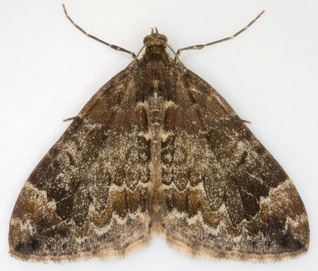Dysstroma - confusing specimens

1. D.citrata; Fersit, Argyll; 28/07/2013; fw 16.0; male
The forewing central projection is of intermediate length (equivocal) with rounded apices (favours CMC). The central of the 3 hindwing cross-lines shows a 90 degree angle (favours DMC if this is the correct line to use) but the proximal cross-line usually goes through the 'central' spot and it clearly doesn't in this specimen, casting some doubt as to which is the median cross-line. The aedeagus and cornuti clearly favour DMC (assuming my assessment of the difference between the species is valid). And all the other specimens I obtained at Fersit were DMC.
The forewing central projection is of intermediate length (equivocal) with rounded apices (favours CMC). The central of the 3 hindwing cross-lines shows a 90 degree angle (favours DMC if this is the correct line to use) but the proximal cross-line usually goes through the 'central' spot and it clearly doesn't in this specimen, casting some doubt as to which is the median cross-line. The aedeagus and cornuti clearly favour DMC (assuming my assessment of the difference between the species is valid). And all the other specimens I obtained at Fersit were DMC.

2. D.truncata?; Dornie, Ross-shire; 10/09/2014; fw 14.2mm; male
The forewing central projection is of intermediate length (equivocal) with pointed apices (favours DMC). The central hindwing cross-line shows an obtuse angle (favours CMC) but this line is somewhat more angulate than is typical for CMC. The aedeagus shows a narrow cornutal bundle (favours CMC). The cornuti are aberrant (in my experience so far) in that the cornuti are larger on one side than the other. All other confirmed Dysstroma obtained in a week at Dornie were DMC.
The forewing central projection is of intermediate length (equivocal) with pointed apices (favours DMC). The central hindwing cross-line shows an obtuse angle (favours CMC) but this line is somewhat more angulate than is typical for CMC. The aedeagus shows a narrow cornutal bundle (favours CMC). The cornuti are aberrant (in my experience so far) in that the cornuti are larger on one side than the other. All other confirmed Dysstroma obtained in a week at Dornie were DMC.

3. D.truncata?; Westcliff-on-sea, Essex; 19/05/2014; fw 16.9mm; male
The forewing central projection is shortish with rounded apices (favours CMC). The central hindwing cross-line is distinctly angulate with a 90 degree angle (favours DMC). The aedeagus and cornuti are typical for CMC. All other confirmed Dysstroma obtained in my garden have been CMC.
The forewing central projection is shortish with rounded apices (favours CMC). The central hindwing cross-line is distinctly angulate with a 90 degree angle (favours DMC). The aedeagus and cornuti are typical for CMC. All other confirmed Dysstroma obtained in my garden have been CMC.












